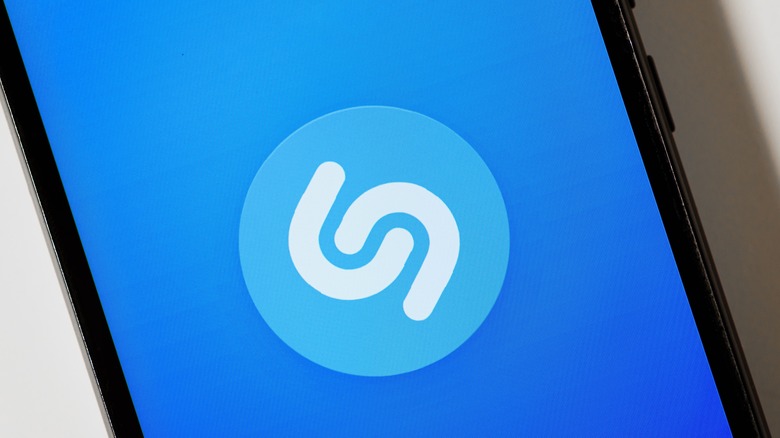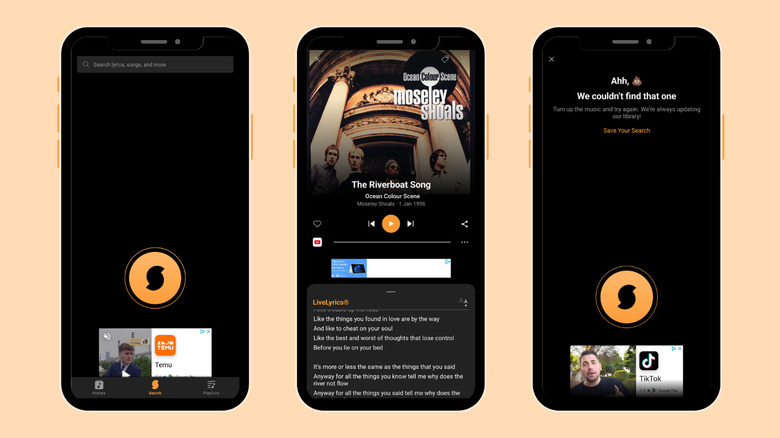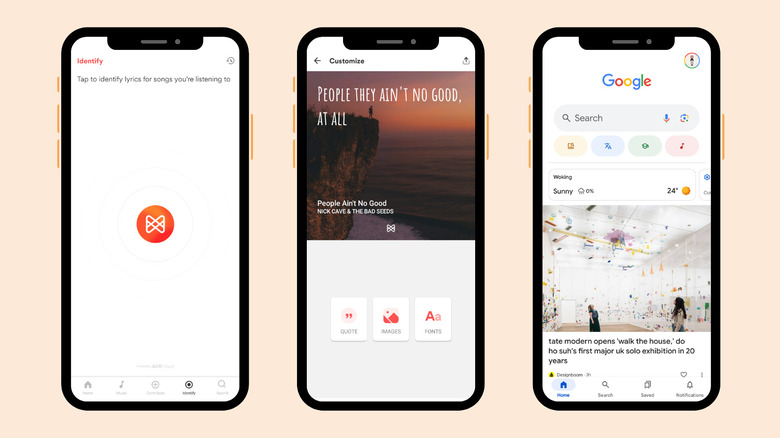What's The Best Alternative To Shazam For Android Users?
It's usually easy to find out what song you're listening to, you just check Spotify (or your other streaming service of choice). Even radio station playlists are easy to access online. However, sometimes you need a bit of help. For example, you might want to identify a song from a commercial or TV show. Or your neighbor might be blaring their playlist at such high decibels that you can hear it through the walls, and you're intrigued by what they're listening to. If you're using a music identification app, you need it to be fast and accurate. Shazam does both those of things extremely well.
Shazam was launched in the United Kingdom in 2002. Back then, you'd ring a phone number, hold your phone up to record a song for 30 seconds, and it would (for a small fee) send you a text with the name of your song. It's moved on since then. In 2018, Shazam was bought by Apple. Despite being an Apple product, you can still use it on Android phones. (This isn't the only Apple app available to Android users. Apple TV was also recently made available.) Shazam can be linked, as you would expect, to an Apple Music account, but it also works with Spotify, YouTube, and Amazon Music. Plus, it's free to use.
The one big drawback is that Shazam doesn't help you identify earworms. If you have a song rattling around in your brain that you can't identify, humming it to Shazam won't get you anywhere. For that, you'll need Shazam's biggest competitor.
SoundHound is Shazam's biggest competitor and best for identifying earworms
SoundHound is the next biggest app for music identification, after Shazam. According to Google Play Store, SoundHound has around 100 million users, compared to Shazam's 500 million. It works pretty much the same way as Shazam. The search page has a big round button in the middle that starts the identification process. It recognizes songs in seconds and provides track details and lyrics. You can add songs to a playlist or share a link. To play the full song from SoundHound, you'll need to connect the app to Spotify or select to open it on YouTube. There's also an option to play a 30-second preview within the app.
Its main advantage over Shazam is its ability to recognize songs that you hum or sing to it. This isn't as reliable as its results when it's listening to proper songs. It recognized about half the songs I sang, hummed, sang, or scatted. I am tone-deaf, so that probably didn't help. People who can produce a tune that bears some relation to the original may have more luck. The 30-second preview would be a really useful feature here to check if it has identified an earworm correctly. Unfortunately, I couldn't get the preview to work successfully when I was testing it.
Unlike Shazam, SoundHound's free version contains ads. These rather spoil the minimalist look of the app, but thankfully, don't interfere with the functionality and are easy to ignore. If you want an ad-free experience, you can download SoundHound Infinity, which costs $5.99. I didn't test the paid version, but since it doesn't seem to offer any benefits beyond removing some unobtrusive ad panels, I'm not sure it's worth the money.
Musixmatch and Google are also worth checking out
If Shazam or SoundHound aren't for you, there are other music identification apps available in the Google Play Store. I quite liked Musixmatch, a music publisher and lyrics catalog that also identifies songs. During my brief test, I found it was slightly slower than Shazam and SoundHound at identifying more obscure songs, but it's still impressively accurate. Musixmatch is lyrics-focused, so after identifying a song, it takes you straight to a page of lyrics.
One noteworthy feature is the option to create "lyrics cards." You can choose a background and font and turn any lyric from a song into a mini motivational poster. Obviously, I amused myself here by choosing the most inappropriate song lines and pairing them with inspiring backgrounds and frivolous fonts. It also has a translation feature, but this isn't available for every song. Like Shazam, Musixmatch needs to hear the real song and won't be able to identify music from your hummed or sung versions.
As a final note, if you've got Google on your phone, you don't actually need to download a specific app. Simply open the Google app on your phone and select the musical note icon. This was extremely fast and accurate when I tested it. Google also identifies songs from your hummed or sung renditions. My only complaint here was that it provides a percentage for how much your performance matches the one it's suggesting. I didn't need to know that my rendition of "Singin' in the Rain" was only a 30% match for the Gene Kelly version. I know I can't sing, but Google didn't need to be so rude about it.


